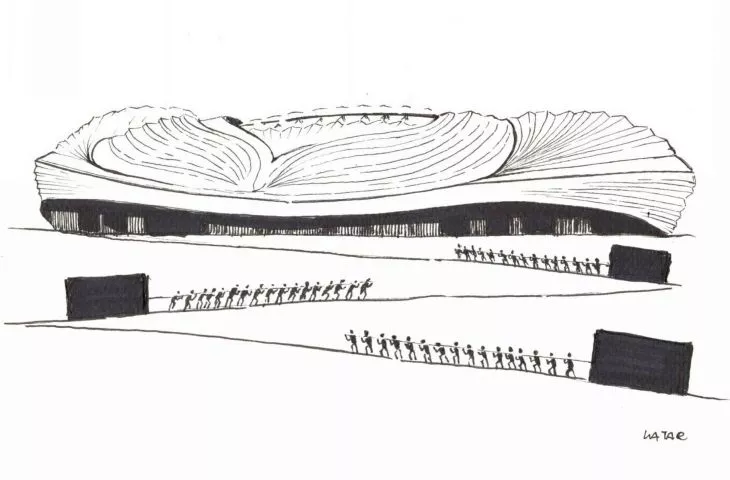Archi-washing
Why do you need it? Why mix architecture with politics ," an architect asked a few years ago during an academic conference. My paper concerned the troublesome legacy of Italian fascism and dealt with the difficulty of constructing a narrative that combines the outstanding aesthetic qualities of selected buildings with the political and historical context of their creation.
The events of recent weeks reminded me of that conference talk a few years ago. First there was the internet storm around the (excellent) cover that Jakub Szczęsny designed for "Architecture and Business." Then emotions were ignited by the visualization of hundred-meter-high skyscrapers in Międzyzdroje, designed in accordance with the law. And recently, social media has been discussing the choice of this year's Pritzker Prize winner.
If they choose (Francis) Kéré or (David) Adjaye it will be a political choice , one commentator said.
And one wanted to ask, wouldn't David Chipperfield, Kengo Kuma or Bjarke Ingels be a political choice? How easy it is for us to treat our vision of the world as "natural" and explain any changes with unspecified "politics"!
Well, precisely, why do we need politics? Let's deal with architecture! It is as if architecture itself never and nowhere depends on politics....
Over the last hundred years, architects have built themselves a cocoon. A protective armor consisting of the concepts of "beauty, goodness, truth". An armor that would protect the great and the small. It was worn by Mies van der Rohe drawing banners with swastikas fluttering above the modernist pavilion of the Third Reich. Le Corbusier offering his services to Stalin and the Vichy government. Walter Gropius writing to Joseph Goebbels.
Today, the shiny knocker has tarnished and begun to corrode. For many years we have been observing a phenomenon that we can call arch-washing. It was accurately characterized by Deyan Sudjic in the pages of his book "The Edifice Complex," describing the process of so-called warming the image of regimes with the help of modern architecture.
Few successful architects, whether they want to or not, can avoid creating a building with political dimensions. And almost every leader uses architects for political purposes1.
We can even go a step further and, following Michael Sorkin, repeat that architecture is always political2.
Archi-washing represents a phenomenon similar to popular sports-washing, in which professional sports act as makeup to cover up human rights violations and dictatorial inclinations. A vast stream of petrodollars from Qatar and Saudi Arabia feeds into the accounts of soccer clubs. Neither the players running on the turf nor the millions of fans seem to notice that the money comes from the governmental spheres of countries that punish homosexuality or adultery with death.
"Only an idiot would say no," - countered Jacques Herzog when asked about his participation in the competition to design the Beijing Olympic stadium3. "We have to be pragmatic, " added Rem Koolhaas, whose studio created the state television building in Beijing. I guess we should appreciate the sincerity of the two designers. They did not hide behind platitudes about the search for beauty and truth. However, does such a presentation change anything? Does Koolhaas's sincerity make the Chinese media more respectful of freedom of speech, and does the authorities of the Middle Kingdom not persecute Uighurs or Tibetans?



An illustration inspired by the design of a television building in Beijing by the OMA studio
il. Błażej Ciarkowski
Zaha Hadid Architects studio has created a design for a stadium for the World Cup in Qatar. The impressive facility is being built, like most of the infrastructure associated with the event, thanks to the almost slave labor of immigrants from Nepal and Bangladesh. Working in inhumane conditions and poorly paid, they are building the image of a modern country. Are the architects responsible for the fact that more than 6,000 workers have been killed during the work to date? No, that would be a significant abuse. But can we assume that the designers, when taking on the assignment, did not know how it would be implemented?
Illustration inspired by the design of a stadium in Qatar by Zaha Hadid Architects
il. Błażej Ciarkowski
A contract in Qatar is not just another zero on the company's account. It is also prestige, an opportunity to emphasize the dominant position in the world of architecture. China and the Arabian Peninsula have become the show window of modern construction. They provide almost unlimited opportunities that are no longer offered by Europe or America. With the vision of creating a work of "lasting, useful and beautiful" in mind, one can turn a blind eye to the fact that the law in the United Arab Emirates still provides for the inhuman punishment of death by stoning for the "crime" of adultery.
We can also consider modern developments in the Far East and Middle East in neo-colonial terms. The Burj Khalifa in Dubai (design: SOM), the National Center for the Performing Arts in Beijing (design: Paul Andreu) or the Capital Gate in Abu Dhabi (design: RMJM - Robert Matthew Johnson Marshall) are examples of the superficial Westernization of space, where "Western" seems to mean "modern" and "original." Investors associated with power circles want to emphasize their progressiveness and strengthen their symbolic ties to the West, while architects readily acquiesce to this and often treat local building tradition as a kind of decoration applied without a deeper understanding of the essence of things. This was pointed out by architect Krzysztof Wiśniowski, who worked in Kuwait for over twenty years and observed with sadness the displacement of local construction by "Western" architecture.



illustration inspired by architecture in Dubai
il. Blazej Ciarkowski
Architects and urban planners don't have the power to change the world, but that doesn't mean they should accept reality "as is." The first step toward expressing this "disagreement" may be to accept that architecture is not (and never has been) apolitical. Dariusz Herman summed up the issue of starchitect participation in the implementation of the Beijing Olympic investments:
If it is not a question of morality it is certainly a question of taste3.
In turn, taste (like morality) can vary and depend on many factors - including political ones.
End of Part 1.
PS 1 - The choice of this year's Pritzker Prize winner interests me primarily as a reaction of part of the environment to changes taking place in the world. I find the very idea of rewarding individuals questionable - after all, as Witold Rybczynski wrote, architecture is not an individual discipline.
PS 2 - I will not be watching the World Cup in Qatar. Just as I did not watch those held in Russia. Instead, I will go to see a local team play.
Błażej Ciarkowski
1 D. Sudjic, The complex of the edifice. The architecture of power, Warsaw 2015.
2 https://failedarchitecture.com/architecture-is-never-non-political-michael-sorkin/
3 A. Rasmus-Zgorzelska, Architecture on the dark side of power, "Architektura-murator "2009, no. 3.



















